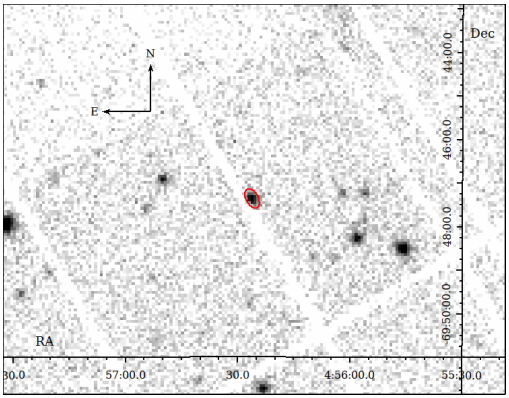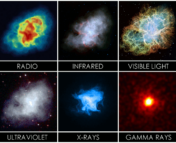Title: Discovery of a magnetar candidate X-ray pulsar in the Large Magellanic Cloud
Authors: M. Imbrogno, G. L. Israel, G. A. Rodríguez Castillo, et al.
First Author’s Institution: Dipartimento di Fisica, Università degli Studi di Roma “Tor Vergata”, via della ricerca Scientifica, Italy.
Status: Accepted to MNRAS [open access]
In the vastness of our universe lie some of the most enigmatic and powerful cosmic beasts called magnetars. They possess extreme magnetic fields, thousands of times stronger than those of typical neutron stars (about a trillion Gauss)! There are only about 30 known magnetars to date and astronomers remain puzzled by the mysteries surrounding these captivating objects. Despite extensive research, the specific mechanisms governing the formation of magnetars, particularly those leading to the extreme magnetic fields observed, are not fully understood. Astronomers still do not know the energy source that drives magnetars activities.
Magnetars, the Extreme Beasts
Magnetars are an extreme class of young neutron stars, remnants of massive stars that have undergone supernova explosions. As Paul Sutter aptly put it, “Magnetars are a special kind of neutron stars, and neutron stars are a special kind of dead star”. What sets magnetars apart is their magnetic fields, which can exceed tens of quadrillion times stronger than the Earth’s magnetic field (~0.5 Gauss) and put your trusty fridge magnets (a strong one could have ~100 Gauss) to shame.

Due to their intense magnetic fields, magnetars show significant flux variability and sporadic strong burst events (or flares, see Figure 1) in the X-rays and gamma-rays, making them detectable from a great distance. These X-rays and gamma-rays bursts are typically how magnetars are discovered. (You can learn more about these extreme beasts in this exciting bite or learn more about their structure in this bite).
The Serendipitous Discovery in the Clouds
The Large and Small Magellanic Clouds are satellite galaxies of our Milky Way. Visible to the naked eye from the southern hemisphere, these galaxies offer an excellent testbed for studying astronomical phenomena beyond the boundaries of our galaxy. In today’s paper, the authors found an unexpected source while searching for new high-energy sources in these clouds within the XMM-Newton archival data. They discovered a strong periodic variation in the X-ray flux from a previously unclassified source in the outskirts of the Large Magellanic Cloud, known as 4XMM J045626.3-694723 (yes, it is a mouthful!), or simply J0456 for short (see Figure 2). After conducting detailed analysis of the periodicity in the J0456 X-ray emissions, along with examining its X-ray and optical spectral data, the authors found that the characteristics of J0456 are consistent with those of a magnetar.

The Nature of LMC’s Newest Beast
Our authors employed the epoch folding technique, a widely used method in X-ray astronomy for detecting periodic pulsations, on the XMM-Newton archival data to estimate the rotation period of J0456. They obtained a value of 7.25 seconds, strongly indicating a rapid rotation period typical of spinning neutron stars, which fall within the range of milliseconds to tens of seconds.
Once the authors determined its period, the next crucial question is to identify the type of neutron star J0456 represents. A key characteristic that can be derived from a neutron star’s period is called the period derivative. This value helps determine whether the neutron star is isolated (spin-down, where the rotation period increases with time, indicating that the neutron star is slowing down) or it is in an accreting system (spin-up, where the neutron star’s rotation accelerates due to the accretion flow from a companion star). Unfortunately, the available data for J0456 are currently insufficient to make the determination based solely on the period analysis.
Another analysis that can be performed using the XMM-Newton data is spectral analysis. By taking the X-ray spectrum of J0456, today’s bite authors fit several theoretical models to identify the one that best matches the data and, eventually, determined the flux from the best-fit parameters. Notably, the best-fit model for J0456 aligns with the model commonly utilized to fit magnetars spectra. Additionally, the X-ray flux derived from the best-fit model appears to be too low for a spinning neutron star with a period of 7.25 seconds in an accreting system.
The authors also conducted a follow-up observation of the J0456 location in the optical wavelength to look for a potential optical counterpart, using the 11-m Southern African Large Telescope (SALT). Within the J0456 region, they found only one faint stellar object. However, its optical spectra do not exhibit the emission lines typically associated with objects that have experienced material mixing from their companion stars. Instead, the spectral shape and the identified lines are consistent with the spectra of late-type stars (spectral class G-K). This suggests that J0456 is less likely to be in an accretion system.
Based on these derived characteristics of J0456 from the X-ray period and spectral analysis, along with the optical data analysis, the results favored a magnetar nature for J0456. Among the 30 known magnetars, only two of them are located in the Magellanic Clouds. Therefore, J0456 stands as the third magnetar to be found outside our galaxy.
One of the objectives in studying magnetars is to gain a better understanding of their extreme magnetic fields and the mechanisms regulating their behavior. Astronomers aspire to unravel the processes that lead to the creation of these rare beasts, thereby shedding light on the extraordinary conditions in which they arise. The authors’ work also underscores the significance of archival data searches in modern astronomy. With the wealth of data collected over decades from various observatories, space missions, and surveys, the potential for new discoveries is immense. By employing suitable data mining techniques, we can uncover numerous objects that may have otherwise gone unnoticed, hidden in the vast pile of archival data.
Astrobite edited by Lucas Brown
Featured image credit: ESA/ATG medialab




